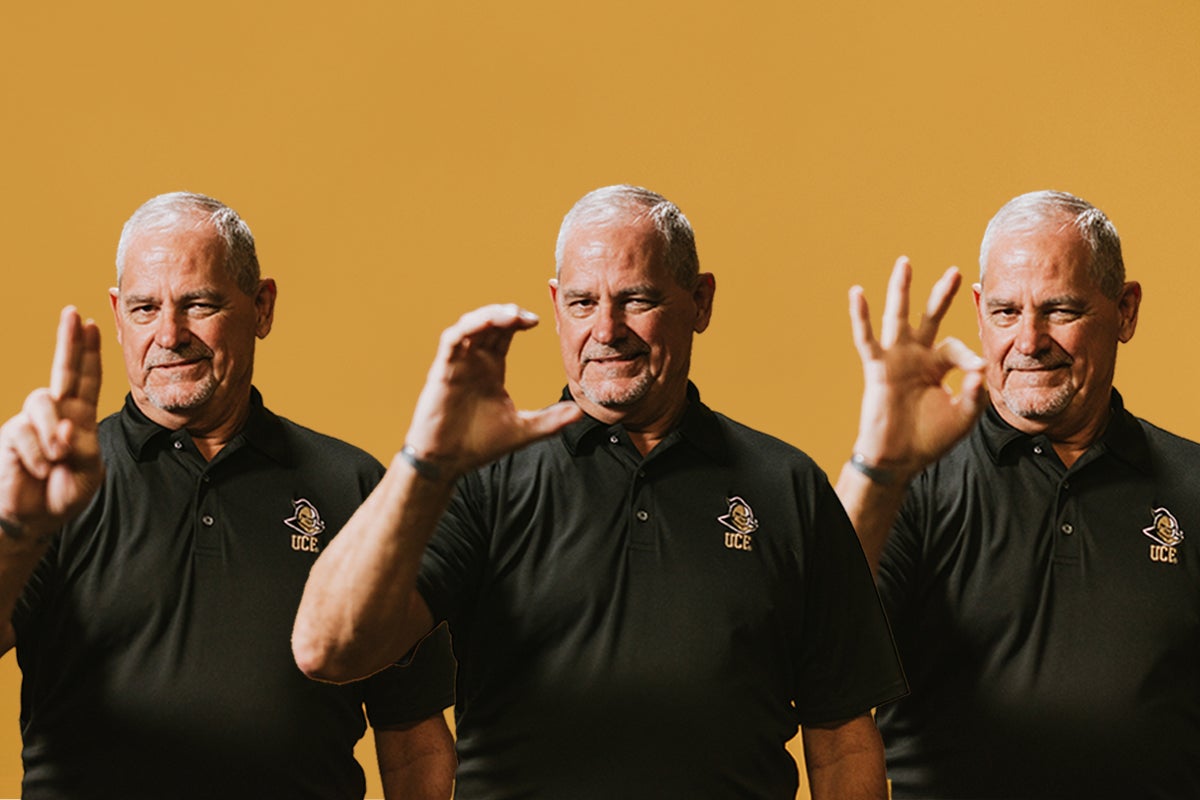Class name: ASL 2140 – Introduction to American Sign Language
Instructor: William “Bill” Cooper, professor of American Sign Language and advisor for UCF’s American Sign Language Club
When is this course offered?: Fall, spring and summer semesters
How many students are typically in a class?: About 30
Are there any prerequisites for this course?: No.
From the Professor
How would you describe this course in 10 words or less?
Opportunity to learn about Deaf* culture and basics of ASL.
Why should students take this course?
To gain the knowledge on how to sign with people who are Deaf.
What are some things students learn in this course?
Students will learn basic signs, phrases in ASL and Deaf history/culture. ASL is not a universal language and while it uses the same alphabet as English it is not a subset of the language and there are regional variations. ASL has its own linguistic structure. For example, ASL doesn’t use pronouns, articles like “the” and “a”, prefixes, suffixes, and verb conjugations, as all verbs are present tense.
Deaf culture is the set of social beliefs, behaviors, art, literary traditions, history, values, and shared institutions of communities that are influenced by deafness and which use sign languages as the main means of communication. Members of the Deaf community, which may include hearing family members of deaf people and sign-language interpreters, tend to view deafness as a difference in human experience rather than a disability or disease. Many members take pride in their Deaf identity.
What does the coursework entail?
The coursework entails practicing through an interactive workbook and video resources, including a fingerspelling, which is signing each letter of a word, video each student must record on their own and upload to a YouTube account for viewing. The class covers five units and there’s an exam and quiz for each of those units. There are also five vocabulary quizzes, homework assignments and a final exam. Participation is extremely important in this course, so there’s a grade for that as well.
As someone who is deaf, what are some misconceptions people may have about individual like you or those who are hard of hearing?
Many people make the assumption that all deaf people are completely and totally deaf. There are different degrees of hearing loss. Some people who are legally deaf prefer to be called hard of hearing. Some people who are legally deaf prefer to be called Deaf. It depends on the individual’s preference. Some people also believe deaf people cannot speak, but not all deaf people are the same. Some deaf people speak very well and clearly, while others choose not to use their voice especially if their speech is unintelligible or they have a “deaf accent”. There are also assumptions that deaf people are not as intelligent as hearing people. Deaf people are not dumb, just like hearing does not make you intelligent. Deaf people can do everything a hearing person can do, except hear. This includes driving. It has been proven that deaf or hard of hearing people are better drivers than hearing people and have fewer accidents. Deaf people are more visually aware of their surrounding while driving compared to hearing people. A hearing test is not a prerequisite to obtain a driver’s license. The flashing lights on ambulances and fire trucks are visible.
What do you hope stays with students after they have completed this course?
By end of semester, I hope students will be able communication with Deaf people by 80-90% immersion. I also hope that we’ll offer a major or minor in Deaf studies or ASL interpreting in the future so students can learn even more about the language.
Communication sciences and disorders student Alyssa Zunic was the interpreter for this video.
From the Student
Jannet Salman, human communications with a track in interpersonal relationships
Why did you want to take this course?
I was always intrigued by sign language and wanted to learn more about the Deaf community and culture.
What is the most interesting thing(s) you learned in this course?
The most interesting thing about this course is the history of ASL. Learning about the people who influenced the progression of Deaf education in this country, and those who hindered it. The language itself wasn’t developed until the 1800s, and even then, took many years later to be accepted by society and taught in schools. Fun fact: The football huddle was created by a student at Gallaudet University, a school for the deaf and hard of hearing, so that the other deaf teams could not see what they were signing to each other.
What was the most challenging aspect of this course?
Learning a new language is challenging in of itself. However, professor Cooper incorporates interactive activities that cater too many different learning styles. In my opinion, the most challenging aspect of this course was learning the grammar structure. While the language is heavily influenced by English, the grammar rules and sentence structure are completely different. ASL is its own language as any other spoken language.
How did you feel about your ability to communicate through American Sign Language by the end of this course?
I feel much more comfortable and confident in my ability to communicate in sign language; however, I still have a lot to learn. ASL 1 is a great introduction to the basics of the language. I also feel that my awareness and knowledge on Deaf culture has increased significantly.




